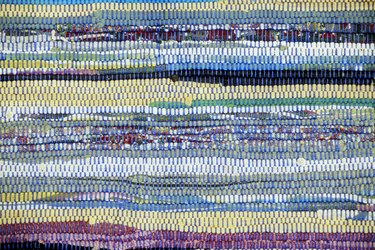Things You'll Need
Sharp scissors or rotary cutter
Cutting mat (if using rotary cutter)
Loom

One of the best ways to recycle old clothing is to make rag rugs out of your worn-out clothes. Traditionally cloth strips are used as the weft, or cross-wise filler, in the rug, and a strong cotton yarn is used as the warp or length-wise thread. Almost any kind of old clothing will work as rag rug weft, but you may not be able to use every single piece, such as pockets and collars, which are too small to use as strips.
Step 1
Make sure you already have a warp for rag rugs beamed, threaded and sleyed through the reed on your loom. Assemble the clothes you are planning to use as weft. There may be different weights of fabric in your collection, such as denim jeans, cotton shirts and maybe jackets. These will all have to be cut differently.
Video of the Day
Step 2
Choose the lightest fabrics first, the ones that are thin and easy to cut. Take your scissors and cut the clothing apart at the seams first. Cut away any flat-felled seams or seam allowances. Each piece of clothing should be disassembled. You can leave sleeves assembled into a tube; however, for cutting in a different way. Take the pockets, collars and button bands off the shirts and discard.
Step 3
Take one large piece of fabric, for example the back of a shirt and cut one strip 1 inch wide lengthwise. Now roll that strip into a tight "cigar." If it is about the width of a pencil, then that's a good width for rag rug weft. Continue to cut strips of fabric from the clothing that is the width you need for a pencil-width bundle. Cut the strips lengthwise, as crosswise strips fray more easily. Continue to cut up the shirt in this manner. Cut the sleeves in one long spiral that is the same width as the other strips. Insert a few of these strips into the warp shed on the loom to check to see if you think they look good when beaten in.
Step 4
Assemble the heavier-weight clothing such as jeans and jackets. These will need to be cut into narrower widths as the fabric itself is heavier. Try 1/2 inch strips first, again cutting lengthwise. Roll into a cigar and see if it looks like a pencil. If so, insert into the shed on the loom to test. If it looks good, continue to cut into smaller strips. Jeans can also be cut in the spiral method to avoid having to take the pieces apart into flat pieces.
Step 5
Sew the strips of like-weight fabric together into one long strip if desired, to make weaving go faster. This can be done on the machine or by hand. Overlap the ends by one inch, fold the overlap in half lengthwise, and stitch. It is not necessary to cut the thread each time you stitch 2 ends together. Continue overlapping, folding and stitching. Cut the threads when you are ready to wind the long strip onto the rag shuttle. Cutting pant legs and sleeves in a spiral means that you have less of this joining to do.
Tip
You can use just about any old clothes in rag rugs, including tee shirts and other knits. Old bath towels and sheets are also useful weft. Scandinavian weavers like to weave with bias strips as they are more elastic and fray less. You can make a long strip of bias tape for weaving by cutting the fabric on the bias and then sewing the bias strips together.
Warning
Don't mix fibers in one rug: use all wool or all cotton in each rug, but not both in the same rug.
Video of the Day